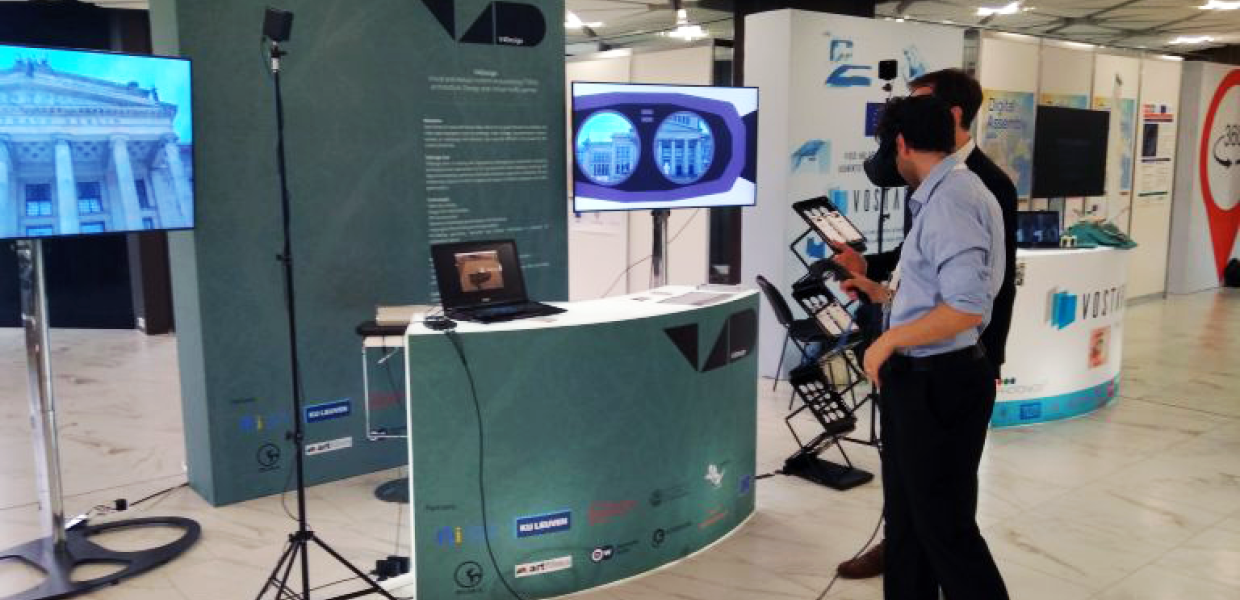How to bring digital cultural heritage to 3D design and virtual reality
As the technological capabilities to digitise cultural objects in 3D increases, so too does the value of these data sources for architects, designers, and video game creators. The real challenge lies in making 3D cultural heritage easily accessible and reusable for those audiences. That is precisely the challenge that the V4Design project is taking on.

- Title:
- V4Design booth at Digital Assembly in Sofia in June 2018
- Creator:
- V4Design
- Date:
- 2018
- Copyright:
- CC BY
As several Virtual Reality and 3D projects that reuse cultural heritage can attest, it’s not easy to seamlessly import digital cultural heritage objects/ into a 3D-modelling environment. It’s a long and often painstaking process to create a reproduction of a painting by Rembrandt in your VR museum experience or to reconstruct the Venus de Milo in your 3D-modelling program. A lot of GLAMs producing full 3D digital objects don’t release those models for free, raising the barrier to entry for reuse of cultural heritage. On top of that, creating 3D models isn't cheap.
There is, however, an immense amount of 2D digital cultural heritage content. What if we could bring ready-made 3D objects closer to the audience that wants to reuse them, and make it easier for that audience to reuse 2D cultural heritage in a 3D environment at the same time?
The goal of the V4Design project is to make it as easy to reuse cultural heritage in a 3D environment as it is to drag and drop. We aim to do this by importing cultural heritage assets from a number of sources, enriching and transforming them to be easily reusable in 3D programs, and then serving them through plugins into your favourite 3D editing tool (e.g. Rhino3D, Unity). This is important because of the current size and growth of the 3D and VR creative spheres, and those audiences could benefit from initiatives focused on providing them with useful source data for their work. (Watch the video below for more info!)
Europeana is filled with exciting cultural heritage, a lot of which is free to reuse and repurpose by all. Not a lot of the content is in 3D though, and when it is, it’s mostly stored in non-reusable formats like 3D PDF. There have been efforts to address this, but none that have reached conclusive success. The V4Design project is looking at this problem from another angle: instead of getting more 3D objects in Europeana, V4Design is researching ways to create 3D objects from previously digitised 2D cultural heritage material. These are state-of-the-art 3D reconstruction tasks that pose their own unique challenges.
It’s impossible to create a 3D model from a single photograph or image of a cultural heritage object. This makes the majority of digitised cultural heritage, therefore, ineligible for 3D reconstruction. There’s the possibility of 3D reconstructing an object when several photographs have been taken from the same object, at different angles. It’s also possible to 3D reconstruct objects from a video taken from an object, given the right circumstances. V4Design wants to create an easy tool where you can input your digitised 2D cultural heritage objects, like photo series or historical video snippets, and have 3D objects extracted from them.
On top of trying to create 3D models from already digitised 2D cultural heritage, V4Design further aims to enrich already-existing 3D cultural heritage models. There are already some great sources to find free 3D cultural heritage objects, like SketchFab and MyMiniFactory’s Scan the world. Getting as many of those beautiful 3D objects as close to those who can reuse them as possible is V4Design’s mission for the next two years.
Read more about V4Design on their website, or on their Europeana Pro project page. Are you or your company interested in following up on the latest V4Design news and insight? Don't hesitate to subscribe to the V4Design User group!

